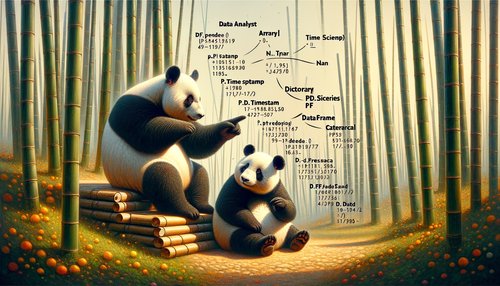Unlocking the Power of Data: A Beginner's Journey into Pandas Data Structures
Welcome to the exciting world of data analysis with Python! If you're venturing into the realm of data science, you've likely heard of the powerful library known as Pandas. This tool is a game-changer for beginners and seasoned analysts alike, offering a vast array of functionalities that simplify the process of data manipulation and analysis. In this blog post, we'll embark on a beginner's journey into Pandas data structures, unlocking their potential and exploring how they can elevate your data analysis projects. Ready to dive in? Let's get started!
Understanding Pandas and Its Core Components
Before we delve into the specifics, let's first understand what Pandas is. Pandas is an open-source library in Python designed for data manipulation and analysis. It provides two primary data structures: DataFrames and Series, which are built on top of the NumPy library, enabling fast and efficient data manipulation.
- Series: A one-dimensional array-like structure capable of holding any data type. It's essentially a column in a table.
- DataFrames: A two-dimensional, size-mutable, and potentially heterogeneous tabular data structure with labeled axes (rows and columns). Think of it as a spreadsheet or SQL table.
These data structures are the backbone of data analysis with Pandas, allowing you to store, manipulate, and analyze data in a way that's both efficient and intuitive.
Getting Started with Series
A Series can be created from a list, array, or dictionary. Here's a simple example to illustrate:
import pandas as pd
# Creating a Series from a list
data = [1, 2, 3, 4]
series = pd.Series(data)
print(series)
This code snippet creates a Series from a list of integers. When you print the series, you'll notice that Pandas automatically assigns an index to each element, starting from 0. This index is used to access and manipulate the data within the Series.
Diving into DataFrames
DataFrames are arguably the most crucial component when it comes to data analysis in Pandas. They allow you to store and manipulate tabular data, where each column can be of a different datatype. Here's how you can create a DataFrame:
import pandas as pd
# Creating a DataFrame from a dictionary
data = {
'Name': ['John', 'Anna', 'Peter', 'Linda'],
'Age': [28, 34, 29, 32],
'City': ['New York', 'Paris', 'Berlin', 'London']
}
df = pd.DataFrame(data)
print(df)
This example shows a DataFrame being created from a dictionary, with the keys acting as column names and the values as the data. DataFrames provide a plethora of functionalities to perform operations such as selecting, editing, and summarizing data.
Manipulating Data with Pandas
Now that you have a basic understanding of Pandas data structures, let's explore some common operations you might perform during data analysis:
- Selection: You can select specific rows and columns using loc and iloc.
- Filtering: Pandas makes it easy to filter data based on conditions.
- Adding/Removing Columns: You can easily add or remove columns to tailor your DataFrame to your specific needs.
- Grouping: With the groupby function, you can group your data for aggregated analysis.
- Merging/Joining: Pandas provides functionalities to merge or join multiple DataFrames based on common columns.
These operations are just the tip of the iceberg. As you become more familiar with Pandas, you'll discover a wealth of functionalities at your disposal.
Conclusion
We've only scratched the surface of what's possible with Pandas data structures, but you should now have a solid foundation to build upon. Remember, the key to mastering Pandas is practice. Try to apply what you've learned here to your own data analysis projects. Experiment with different data manipulations, explore the extensive documentation, and join the vibrant community of Pandas users. As you continue your journey, you'll find that the power of data is truly at your fingertips. Happy analyzing!
Ready to take your data analysis skills to the next level? Dive deeper into Pandas, and don't be afraid to get your hands dirty with real-world datasets. The world of data awaits!
Recent Posts

Unlocking the Power of Terraform: Mastering Conditional Expressions for Smarter Infrastructure Automation

Unveiling the Future: Navigating the Public Interface of Apache Airflow for Streamlined Workflow Management
Apache Airflow
Mastering Workflow Automation: Unconventional Apache Airflow How-To Guides for the Modern Data Enthusiast
Apache Airflow
Mastering the Cloud: Unveiling AWS CloudFormation Best Practices for Seamless Infrastructure Management

